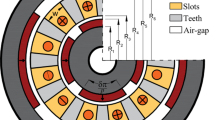Abstract
Permanent magnet synchronous machines with fractional slot stator windings using the tooth coil technology require detailed investigations on the electromagnetic parameters due to a very low number of slots per pole and phase. Finite element analyses of such machines can provide many results and even allow for a comparison of both Y- and Δ-connected stator windings. However, a subsequent application of the frozen permeabilities method allows for a more detailed discussion of effects caused by both permanent magnets and armature stator currents in conjunction with angular rotor position and also different saturation levels. In particular, such detailed analyses are required for high performance electrical drive systems which operate under very fast changing load conditions and run in deep field weakening ranges additionally.
Zusammenfassung
Permanentmagnet-Synchronmaschinen mit Bruchloch-Zahnspulenwicklungen erfordern wegen der sehr geringen Anzahl von Nuten pro Pol und Strang detaillierte Untersuchungen zu deren elektromagnetischen Parametern. Numerische Analysen mit der Methode der Finiten Elemente liefern solche Ergebnisse und erlauben in Bezug auf diese auch den Vergleich von Stern- und Dreieckschaltung der Statorwicklung. Eine tiefergehende Behandlung dieser Ergebnisse kann durch die Anwendung der Methode der festgehaltenen Permeabilitäten oder Reluktivitäten erfolgen. Damit lassen sich die Einflüsse der Permanentmagnete und der Statorströme in Abhängigkeit von Rotorwinkellage und unterschiedlichen Sättigungszuständen näher darstellen. Insbesondere sind solche Detailanalysen bei hochausgenutzten Synchronmaschinen für die elektrische Antriebstechnik notwendig, wenn diese unter rasch wechselnden Belastungen auch im tiefen Feldschwächbereich mit dementsprechend immer anderen Sättigungszuständen betrieben werden.

















Similar content being viewed by others
References
Bianchi, N., Bolognani, S., Chalmers, B. J. (1998): Comparison of different synchronous motors drives for flux weakening applications. In Proceedings of the 13th international conference on electric machines, ICEM, Istanbul, Turkey.
Miller, J. M., McClear, P. J., Lang, J. H. (1998): Starter-alternator for hybrid electric vehicle: Comparison of induction and variable reluctance machines and drives. In Proceedings of the IEEE industry applications society 33rd annual meeting, IAS’1998, St. Louis, MO, USA.
Huth, G. (2005): Permanent magnet excited AC servo motors in tooth coil technology. IEEE Trans. Energy Convers., 20(2), 300–307.
El-Refaie, A. M., Shah, M. R. (2008): Comparison of induction machine performance with distributed and fractional slot concentrated windings. In IEEE industry applications society annual meeting, IAS’2008, Edmonton, AB, Canada.
El-Refaie, A. M. (2010): Fractional slot concentrated windings synchronous permanent magnet machines: opportunities and challenges. IEEE Trans. Ind. Electron., 57(1), 107–121.
Schmidt, E., Susic, M., Eilenberger, A. (2011): Design studies on a permanent magnet synchronous machine with Y- and Δ-connected stator winding. IEEE Trans. Magn., 47(05), 1042–1045.
Schmidt, E., Susic, M. (2011): Finite element analyses of permanent magnet synchronous machines with fractional slot tooth coil windings. e&i, Elektrotech. Inf.tech., 128(3), 86–94.
Bianchi, N. (2005): Electrical machine analysis using finite elements. Boca Raton: CRC Press.
Walker, J. A., Dorrell, D. G., Cossar, C. (2005): Flux linkage calculation in permanent magnet motors using the frozen permeabilities method. IEEE Trans. Magn., 41(10), 3946–3948.
Tangudu, J. K., Jahns, T. M., El-Refaie, A. M., Zhu, Z. Q. (2009): Segregation of torque components in fractional slot concentrated winding interior PM machines using frozen permeability. In Proceedings of the IEEE energy conversion congress and exposition, ECCE, San Jose, CA, USA.
Xia, Z. P., Zhu, Z. Q., Wu, L. J., Jewell, G. W. (2010): Comparison of radial vibration forces in 10-pole/12-slot fractional slot surface mounted and interior permanent magnet brushless AC machines. In Proceedings of the 19th international conference on electrical machines, ICEM, Rome, Italy.
Chu, W. Q., Zhu, Z. Q. (2013): Average torque separation in permanent magnet synchronous machines using frozen permeability. IEEE Trans. Magn., 49(3), 1202–1210.
Park, R. H. (1929): Two-reaction theory of synchronous machines, generalized method of analysis, part I. AIEE Trans., 48(3), 716–727.
Park, R. H. (1933): Two-reaction theory of synchronous machines, generalized method of analysis, part II. AIEE Trans., 52(2), 352–355.
Kovacs, P. K. (1984): Transient phenomena in electrical machines. Amsterdam: Elsevier.
Eilenberger, A., Schmidt, E., Schrödl, M. (2010): Sensorless capability of permanent magnet synchronous machines due to saturation- and reluctance-based coupling effects. In Proceedings of the 1st IEEE international symposium on sensorless control for electrical drives, SLED, Padova, Italy.
Arkkio, A. (1987): Analysis of induction motors based on the numerical solution of the magnetic field and circuit equations. Acta polytechnica scandinavica, Electrical engineering series (Vol. 59). Helsinki.
Bastos, J. P. A., Sadowski, N. (2003): Electromagnetic modeling by finite element methods. New York: Dekker.
Hameyer, K., Belmans, R. (1999): Numerical modelling and design of electrical machines and devices. Southampton: WIT Press.
Author information
Authors and Affiliations
Corresponding author
Rights and permissions
About this article
Cite this article
Schmidt, E. Calculation of electromagnetic quantities of permanent magnet synchronous machines with tooth coil windings using finite elements and frozen permeabilities. Elektrotech. Inftech. 132, 11–17 (2015). https://doi.org/10.1007/s00502-014-0280-3
Received:
Accepted:
Published:
Issue Date:
DOI: https://doi.org/10.1007/s00502-014-0280-3
Keywords
- Two-axes inductances
- Cross-coupling inductances
- Frozen permeabilities
- Permanent magnet machine
- Finite element analysis




